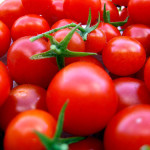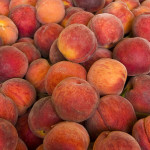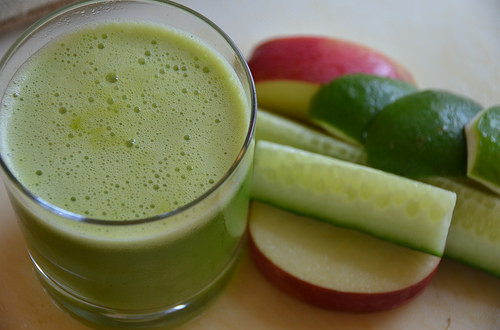by Michelle Sutton-Kerchner
With so many flavorful fruits and veggies in season, it’s time to take advantage of the juicing trend. Here’s how to drink in the goodness …
It is easy to make favorites into juice or smoothies for a healthy snack or mini-meal. Two whole fruits and three to four vegetables are the general daily recommendation. For those who dislike fruits and veggies, enjoying them as a refreshing drink helps them go down smoothly for a balanced diet. Aside from the color, picky eaters may never know spinach or carrots are part of a fruity blend. Carrots paired with pineapples, or spinach with berries, can barely be detected. (Try it to believe it!)
Use the freshest seasonal picks to assure variety, optimum flavor, and minimum cost. It often takes a lot to make a little, so you may benefit from buying produce in bulk. At the peak of freshness, vegetables and fruits tend to dip in price. It is also a great time to stock up and freeze. Allow yourself to enjoy summer favorites baked into pies or casseroles in the heart of January.
In Season Now & Ready for the Blender:
Apricots
Avocados
A variety of berries
Bell peppers
Beets
Cantaloupes
Carrots
Chard
Cherries
 Corn
Corn
Cucumbers
Green beans
 Figs
Figs
Nectarines
Peaches
Plums
Tomatoes
Watermelons
Yellow squash
Zucchini
It Doesn’t Take a Chef
Experiment to determine what you like. There are plenty of recipes for homemade juice and smoothies. A little creativity and nutritional insight are all you really need. If you are looking to overpower the flavor of a bitter vegetable, go for a fruit that is equal in sweetness. Juices lend themselves to a variety of spices. Fresh basil (also in season) adds a touch of sweet to a veggie juice. Pepper can spice it up and cleanse the sinuses.
For smoothies, replace high-calorie additives with healthier options. This should not be a milkshake in disguise. Use fat-free yogurt to enhance consistency. Add low-fat milk and plenty of ice. Drop in chunks of fruit and blend. No sugar or syrups are needed.
Garnish with a sprig of fresh mint from a window herb garden or a slice of fruit. Skip the whipped cream. Pour into a fancy glasses for a summery dessert. Use a travel mug for a power snack on the go.
Do not include too many fruits, especially at the expense of vegetables. This can pack a significant calorie boost unworthy of the nutritional gain. Juicing to lose weight or “cleanse” is unproven in its success. The body self-cleanses through the impressive functions of the kidneys and liver.
Cinnamon helps further sweeten with value. It adds flavor and is a healthy sugar substitute, unlike sugar’s other replacements. A quarter teaspoon daily helps lower cholesterol and triglycerides. It also controls blood sugar levels, which prevents food binging. Used as a spice, cinnamon can help counter the negative effects of fats found in yogurt and milk , both common smoothie ingredients.
Add protein for a more substantial drink to carry you to your next meal. This helps keep blood sugar levels steady and maintain energy. The hunger-satisfying fiber often gained through consumption of produce decreases significantly during the blending or juicing process. Machines separate juice from fiber-packed pulp. Also, many peel the skins prior to blending, which are loaded with fiber and other nutrients. Dietitians recommend eating solid produce in addition to any drinkables to reap full benefits.
As for that pulp, recycle it! Add it back into the juice or cook with it. For smoothies, it provides added thickness. (Think milkshake consistency without the ice cream.) Use it to fortify sauce, gravy, mashed potatoes, broth, and baked goods while adding nutritional value. Think outside the blender.
Protein also powers up a workout, helping build muscle and increase stamina. Consider a protein juice or smoothie before your workout. Blender-friendly protein sources include flax seed, peanut butter, Greek yogurt, and almond milk.
Protein and Your Workout
Fuel your workout well with a protein-enhanced drink. For juice or smoothies enjoyed prior to exercise, increase the amount of ice used. Hydrate and power up simultaneously with a well-crafted drink. Protein also may help the body absorb fluids and aid hydration.

Try to incorporate eight to ten grams of protein per serving. For best results on the Exercise Floor, enjoy about 60 minutes before your workout. Protein delivers amino acids your muscles need to burn fat and recover from a workout session. Carbohydrates replenish your muscles’ energy stores, which are spent after exercise. Vegetables, fruits, and added ice hydrate. The combination delivered in a fresh smoothie or juice complements any workout.
Natural peanut butter is a great source of protein: One tablespoon has about four grams. Studies also show it contains an element that blocks the formation of fat cells. Kids love it, and so does your waistline. Blend frozen bananas and a tablespoon of natural peanut butter until smooth. Top with fresh fruit or a sprinkle of dark chocolate. Pre-workout treat!
Premade protein drinks can be a helpful workout tool. Short on time, it delivers nutrients needed to get through your fitness session or power through lunch during a work crunch. Be sure to read labels. The sugar and calorie counts of these smoothies and beverages vary greatly. Find a reputable brand, then go for flavor preferences. Otherwise, you could unsuspectingly chug down a few hundred calories.
As a staple for weight loss, a diet mainly of juice and smoothies often leaves one hungry to take a bite out of something — and that may be a cheeseburger or cupcake. Use juice and smoothies as an addition to your diet, whether the goal is weight loss or muscle gain.
Yogurt
Yogurt is usually the key ingredient in smoothies. It delivers a creamy, smooth consistency without the fat of ice cream or heavy syrups. Choose this base ingredient carefully. Options are as plentiful as yogurt’s varied contents. Sugar, fat, and protein are the main players in the value of any given yogurt. These ingredients vary widely. Other choices include Greek, Indian, and soy blends to name a few. Some are geared toward low-calorie diets. Others are created to improve digestive health and a large assortment of other nutritional needs.
You’ve carefully picked fruits and veggies to include. Don’t counteract those smart choices by plucking the wrong yogurt from the shelf. Customize your drink with a yogurt that meets your dietary requirements, whether it is extra vitamin D and calcium, mega protein, or a soothing supply of probiotics.
For those working to build muscle and lose weight, Greek yogurt is a good option. Some brands deliver 15 grams of protein or more per serving, with only six grams of sugar, in less than 6 ounces. The calcium content alerts fat cells to reduce cortisol production, which helps you shed pounds (especially belly fat). When strength training, opt for nonfat, plain Greek. Natural sugars in fruit and veggies provide sweetness in a smoothie or a yogurt snack. Sprinkle in cinnamon or a spoon of honey to enhance.
Be careful when comparing yogurts. Serving sizes on the nutrition label vary, as do the containers themselves. What looks like less sugar at first glance may actually be packed into a smaller package.
You don’t need any fancy equipment or complicated recipes. Build juices and smoothies as you do your workout. Pay attention to details, keep it fresh and balanced, and customize it to your tastes and needs.
Chefs recommend you begin by pairing two fruit-and-vegetable combinations.
Toast these easy recipes, packed with fitness-boosting power:
Carrot-Apple Juice
Blend 4 carrots and 1 apple.
10 ounces yields approximately 4 grams protein, 49 grams of carbohydrates, and 200 calories.
And think of the vitamins!
Kale Smoothie
Try this combination using the super-food kale.
.5 apple
2 cups kale leaves
1 cup spinach
1 cup vanilla fat-free yogurt
1 tablespoon ground flax seeds
1 cup ice cubes
12 ounces yields approximately 9.7 grams protein, 177 calories, and almost every identifiable vitamin and mineral, according to perfectsmoothie.com.
Sources
“Juicing for Health and Weight Loss,” by Anna Nguyen at www.webmd.com.
“Navigating the Yogurt Aisle,” by Madeline Vann at www.everydayhealth.com.
“10 Surprising Health Benefits of Yogurt,” by Amanda Pressner at www.fitnessmagazine.com.
Image Credits
Fresh juice (introductory photo): www.flickr.com/photos/61800045@N02/12396321765/
Tomatoes: www.flickr.com/photos/spin_spin/224076652/
Zucchini: www.flickr.com/photos/tobin/193567861/
Peaches: www.flickr.com/photos/calliope/4913425862/
Arm curls: www.flickr.com/photos/121183998@N08/13335780903/
Smoothie: www.flickr.com/photos/miss_yasmina/5700145998/
 Fitness & Wellness News Your Source for Fitness News, Wellness News, Health News, and Nutrition News!
Fitness & Wellness News Your Source for Fitness News, Wellness News, Health News, and Nutrition News!





